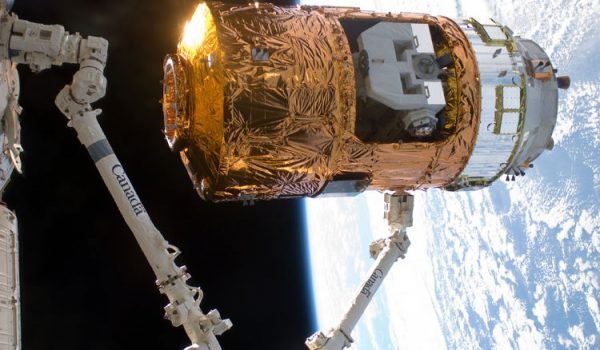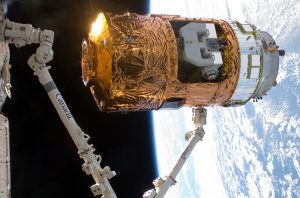
On Saturday, July 21 the H-II Transfer Vehicle-3 (HTV-3) launched from the Tanegashima Space Center aboard a Japanese H-IIB rocket. The robotic vessel will be grappled to the International Space Station on July 27, delivering its 4 tons of cargo.
When HTV-3 arrives at the station, it will be grappled to the Harmony node’s Earth-facing docking port by Flight Engineers Joe Acaba and Aki Hoshide using the Canadarm2 robotic arm. Before docking, the craft will jettison five nanosatellites into orbit. It will also deliver to the station a new Earth observation camera sysem called ISERV that can be remotely controlled by ground based researchers as well as a communication testbed – the Space Communications and Navigation or SCaN. SCaN contains three Software Defined Radios (SDR) designed to address the problem with deep space vessels whose development takes many years resulted in outdated communications equipment by the time they finally launch. SDR circumvents that problem by allowing the equipment to be reconfigured throughout its lifetime to interact with more recently developed instruments. The testbed will be mounted on the exterior truss of ISS.
HTV-3 also carries the two winning science experiments from YouTube’s Space Lab student competition. The winners, Dorothy Chen and Sara Ma working on bacteria virulence and Amr Mohamed investigating the habits of zebra spiders, have already gotten a taste of microgravity aboard a Zero-G flight as part of the joint Google-Lenovo sponsored contest. Now, they will see their experiments in live video broadcast from aboard ISS.
With HTV-3 en route, the prior supply vessel, the Pirs-docked Progress M-15M was loaded with waste products to burn in the atmosphere. Before being sent on its way on July 30, however, the Progress is testing out a new docking system. Known as Kurs-Na, the system requires half as many antennae as the current system and is reported to require less power, has updated electronics, and improves safety. Progress M-16M follows close on the heels of HTV-3, with an August 1 launch scheduled from Baikonour Cosmodrome.
The HTV-3 cargo vessel is the third in the line to be sent to ISS. Nicknamed Kounotori, or White Stork, the craft will remained docked at the Harmony node until September when it will be released to burn up in the atmosphere.
The video below from JAXA provides a closer look at HTV-3:


















































































































![A trajectory analysis that used a computational fluid dynamics approach to determine the likely position and velocity histories of the foam (Credits: NASA Ref [1] p61).](http://www.spacesafetymagazine.com/wp-content/uploads/2014/05/fluid-dynamics-trajectory-analysis-50x50.jpg)



Leave a Reply